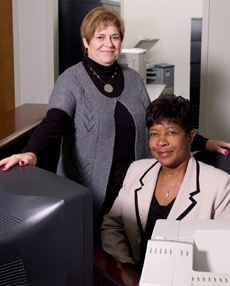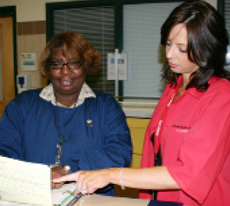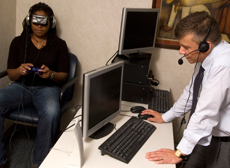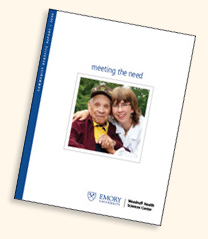Hard dollars and plain sense

The nurses—"guardian angels"— he called them, gave the baby and grieving father special attention. Bill could barely think beyond the loss of his wife and the miracle of his boy.
by Sylvia Wrobel
Sometimes universities are regarded as ivory towers, focused more on thinking and ruminating and less on doing. The truth is, universities are making very concrete contributions to their communities.

Emory's Elaine Dahl (left) from patient financial services and Sandra Mullings (right) from social services worked hard to help Bill Arnold get insurance coverage and charity care after his wife's cerebral hemorrhage. |
Sometimes these contributions translate into hard dollars, like the $5.7 billion economic impact that Emory's Woodruff Health Sciences Center (WHSC) has on the metro Atlanta community each year. But sometimes their value can be measured best by their impact on people's lives. The following are vignettes that illustrate how Emory is meeting a critical need for health care, without regard for patients' ability to pay.
The worst and best of Christmases
This was supposed to be the happiest Christmas ever. Jen and Bill Arnold* were going to celebrate their first anniversary and, three months later, welcome the arrival of their first baby, a boy. What looked like a glitch—Bill being downsized out of his job—had turned into a new job paying an extra $50 per week. Enough money that Jen could keep working on her master's degree and stay home with the baby.
Then everything changed. Jen suddenly became lethargic and confused, struggling to talk. The next few days were a blur: an ER doctor trying to explain cerebral hemorrhage and the need to get Jen somewhere with expertise in high-risk pregnancy, the helicopter vibrating as it lifted into the air, then down again on the roof of Emory University Hospital Midtown. Hours after Jen arrived, unconscious, unresponsive, the two-pound baby was delivered by C-section in an effort to save his life and, perhaps, help his mother. Jen never saw him. Three days later, with Bill's consent, she was taken off life support.
For the next three months, Bill spent as much time as possible in Emory Midtown's neonatal intensive care unit, stroking his son's tiny hand through openings in the incubator. The nurses—"guardian angels," he called them—gave the baby and the baby's grieving father special attention. Bill could barely think beyond the loss of his wife and the miracle of his boy.
In the hospital's patient financial services office, other guardian angels were working on his behalf. Insurance coverage from Bill's previous job had ended December 15, while coverage from his new job had not begun until January 1. Jen's cerebral hemorrhage, the air flight, the cesarean, the NICU, all had taken place during the gap. His former and new employers tried to ensure that their insurance plans covered as much as possible, before and after the gap. What was not covered, however—about $20,000—was classified as charity care under federal guidelines and became Emory Midtown's contribution. Bill was immensely grateful, but the money was not what he—or the doctors and nurses—were smiling about when he left the hospital holding his healthy son.

After an auto accident, Rebecca Moore (right) suffered a collapsed lung, broken bones, torn kidneys, and a severed colon. Social workers helped get the uninsured business owner enrolled in Medicaid to help with her bill. |
Second chance
Rebecca Moore remembers the massive light pole that appeared unexpectedly as she tried to leave the expressway exit. She remembers the impact, the sense that something had gone terribly wrong with her body, the Grady EMS team, ceiling lights flashing by as she was rushed into surgery. Then nothing.
She spent five weeks in a medically induced coma while a team of Emory trauma surgeons and Grady nurses repaired the jumble of injuries she had suffered. The collapsed lung, broken ribs, and leg fractures were standard high-impact fare, requiring multiple plates and screws. But trauma surgeon Christopher Dente and his team also had found massive bleeding in Moore's abdomen. The impact had torn both of her kidneys and severed her colon. In addition to kidney repair (and dialysis), she required a temporary colostomy and a skin graft to cover her abdomen. She remained in the hospital six weeks and returned, two or three times a week, for the following seven months.
The first time Moore asked about how much all this was costing—long before the final surgeries to reverse the colostomy and reconstruct her abdominal wall, before the return visits and twice-weekly physical rehab sessions—the bill had already exceeded $500,000. Two months before the accident, the 32-year-old single mother had had health insurance, but that had vanished when she left her job to work in a restaurant while starting her own business.
Who would pay the mounting costs? During her coma, social workers had helped Moore's family apply for Medicaid. Eventually, the hospital and the Emory Medical Care Foundation, the billing agency for Emory physician services at Grady, received partial payment for the bill, even if only a fraction of the total cost. But the big payoff for Dente and the team who cared for her is the sight of a healthy, happy Moore, now a frequent volunteer at Grady.
The demands of diabetes
Trina's* type 1 diabetes was diagnosed when she was 11 months old. She did not like it one little bit, not the pricks, the injections, or the limits on what she could eat, and especially not the visits to the diabetes doctor. Things got better last year when pediatric endocrinologist Inger Hansen prescribed an insulin pump. Trina started laughing more, sleeping through the night, and waiting patiently while her mother changed the pump's insulin cartridges.
Last year, when the diabetes service that Hansen directs at Emory-Children's Center started a special toddler clinic, doctor visits also became something to look forward to. Trina, now 3, could play under supervisionwith other children her age while her mother participated in educational and support programs with other parents.
Clinicians at the center were surprised then when Trina failed to show up for clinic and her mother stopped calling nurse practitioner Megan Consedine for advice. After the second missed clinic visit, Consedine called the family.
The mother was embarrassed. Trina's father had abandoned the family, lived out of state, and did not know or support the child, she said, but when Medicaid discovered that the father had insurance, they removed Trina from their rolls. Trina's mother had been able to pay for some insulin out of her own pocket but . . . well, not as much as before.
Consedine tried to keep the alarm out of her voice as she asked Trina's mother to please bring her daughter in right away. She assured her that Emory would supply all the insulin for Trina until the mom could clear up the confusion.
Diabetes is an expensive disease for patients, with insulin alone often costing $160 per month and lancets, strips, and other paraphernalia another $200 to $300. Diabetes is expensive also for Emory Healthcare. Although insurance (when patients have it) provides limited reimbursement for physician visits, it does not cover diabetes classes or the hours educators spend each week on the phone with parents. Yet such support is vital to managing diabetes in children, which is why Hansen insists on it for the 1,500 to 1,800 kids seen each year in her clinic.

Emory clinical psychologist Bekh Bradley co-leads a team that helps more than 1,000 Georgia veterans each year deal with reactions to battlefield trauma after they return to civilian life. |
Returning (all the way) home
Ben Johnson* first came to the Atlanta VA Medical Center (VAMC) for help with pain that persisted three years after his humvee had hit an improvised explosive device and burst into flames, searing into his memory the sight and sounds of his best friend being killed. It was not the first death that Johnson had witnessed during two deployments in Iraq.
With more than 1,000 Georgia veterans referred for treatment to the Atlanta VAMC trauma recovery program every year, Emory physicians who practice there have seen virtually every kind of reaction to wartime trauma: veterans who patrol the perimeter of the house, drive in the center of the road, wear combat boots to bed, or keep a gun under the pillow—all symptoms reflecting a type of constant vigilance appropriate to wartime and hard to turn off after a return to civilian life.
In a partnership that reaches back more than 60 years, Emory medical faculty provide virtually all physician care for more than 60,000 veterans seen every year at the Atlanta VAMC, the largest, most complex tertiary care VA facility in the Southeast. Emory scientists also have made the Atlanta VA one of the nation's top VA centers for research, in areas ranging from infectious disease to dementia and traumatic brain injury.
Clinical psychologist Bekh Bradley and psychiatrist Kelly Skelton led the team that began working with Johnson. Suicidal, often irrationally angry toward his wife and children, he agreed with the clinicians that he suffered from post-traumatic stress disorder. But initially, he didn't want to engage in treatment that would address his traumatic memories.
The treatment team agreed instead to focus initially on psychosocial skills that would allow him to better manage his distress. When that was successful, he agreed to a treatment known as "in-vivo" exposure, in which veterans take progressive steps to engage in activities that they have been avoiding. Johnson now can spend time in a crowded mall without undue anxiety. He no longer avoids traffic. He goes grocery shopping during normal hours instead of at midnight.
Following this approach, he felt as if he might be ready to begin working with his therapist on a detailed description of his traumatic combat experiences to gain perspective and learn to regard these memories as memories and not as actual events recurring again and again.
As Johnson relearns how to live outside a war zone, many of his anger problems have subsided, and he no longer contemplates taking his own life. His ongoing care includes psychiatric medications and working with a unit at the VAMC to address problems associated with a mild traumatic brain injury that occurred while he was in Iraq. "It's not a fast cure," says Bradley, "but we have a responsibility to help bring our veterans truly back home again."
*indicates patient names have been changed to protect privacy.



